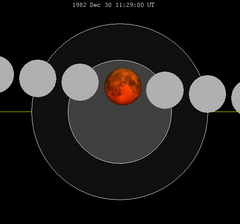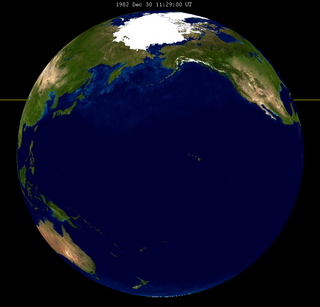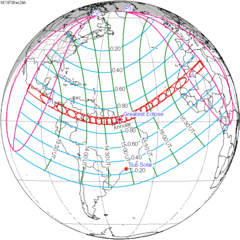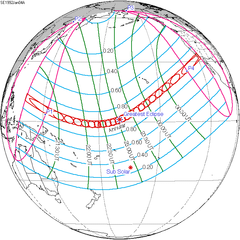
A total lunar eclipse occurred from 5:27 to 11:06 UTC on 21 December 2010, coinciding with the date of the Winter solstice in the Northern Hemisphere and Summer solstice in the Southern Hemisphere. It was visible in its entirety as a total lunar eclipse in North and South America, Iceland, Ireland, Britain and northern Scandinavia.

A total lunar eclipse took place on Friday, February 9, 1990, the first of two lunar eclipses in 1990.
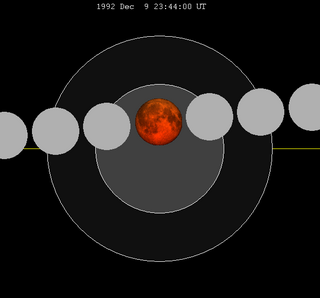
A total lunar eclipse took place on Wednesday, December 9, 1992, the second of two lunar eclipses in 1992, the first was a partial lunar eclipse on Monday, June 15.
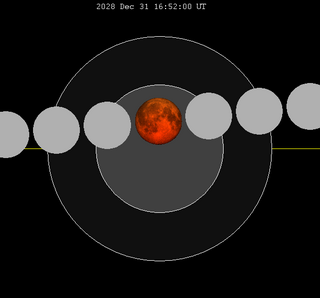
A total lunar eclipse will take place on Sunday, December 31, 2028. It will occur during a blue moon and is the first such eclipse to happen on New Year's Eve and New Year's Day since December 2009, and the first total lunar eclipse on New Year's Day in history. The next such eclipse will be on December 2047.

A partial lunar eclipse was visible on 31 December 2009. It was the last and largest of four minor lunar eclipses in 2009. This lunar eclipse is also notable, because it occurred during a blue moon. The next eclipse on New Year's Eve and blue moon will occur on 31 December 2028.

A total lunar eclipse occurred at the Moon's descending node on 27 July 2018. The Moon passed through the center of Earth's shadow in what was the first central lunar eclipse since 15 June 2011. It was also the second total lunar eclipse in 2018, after the one on 31 January. It was the longest total lunar eclipse of the 21st century, but not the longest in the 3rd millennium. The longest total lunar eclipse of the 3rd millennium will occur on May 12, 2264, lasting 106 minutes and 13.2 seconds, which will be the longest total lunar eclipse since 2000, and the longest one until 3107.
A total lunar eclipse took place on Saturday, January 9 and Sunday, January 10, 1982, the first of three lunar eclipses in 1982. The Moon was plunged into darkness for 1 hour and 17 minutes 39.5 seconds, in a deep total eclipse which saw the Moon 33.103% of its diameter inside the Earth's umbral shadow. The visual effect of this depends on the state of the Earth's atmosphere, but the Moon may have been stained a deep red colour. The partial eclipse lasted for 3 hours and 24 minutes in total.
A partial lunar eclipse took place on Friday, July 17, 1981, the second of two lunar eclipses in 1981. The Earth's shadow on the moon was clearly visible in this eclipse, with 55% of the Moon in shadow; the partial eclipse lasted for 2 hours and 43 minutes.
A partial lunar eclipse took place on Saturday, August 27, 1988, the second of two lunar eclipses in 1988, the first being on March 3, 1988. The Earth's shadow on the moon was clearly visible in this eclipse, with 29.159% of the Moon in shadow; the partial eclipse lasted for 1 hour, 52 minutes and 59.7 seconds. The Moon was only 5 hours and 48 minutes before perigee, making it 6.3% larger than average
A penumbral lunar eclipse took place on Tuesday, December 20, 1983, the second of two lunar eclipses in 1983. At the maximum eclipse, 89% of the Moon's disk was partially shaded by the Earth, which caused a slight shadow gradient across its disc; this subtle effect may have been visible to careful observers. No part of the Moon was in complete shadow. The eclipse lasted 4 hours and 2 minutes overall.

A total lunar eclipse occurred on 31 January 2018. The Moon was near its perigee on 30 January and as such may be described as a "supermoon", when the Moon's distance from the Earth is less than 360,000 km. The previous supermoon lunar eclipse was in September 2015.

A partial lunar eclipse occurred on 19 November 2021. The eclipse occurred towards a micromoon. This was the longest partial lunar eclipse since 18 February 1440, and the longest until 8 February, 2669; however, many eclipses, including the November 2022 lunar eclipse, have a longer period of umbral contact at next to 3 hours 40 minutes. It was often referred to as a "Beaver Blood Moon" although not technically fulfilling the criteria for a true blood moon (totality).
A total lunar eclipse took place on Thursday, September 6, 1979, the second of two lunar eclipses in 1979. A shallow total eclipse saw the Moon in relative darkness for 44 minutes and 24.7 seconds. The Moon was 9.358% of its diameter into the Earth's umbral shadow, and should have been significantly darkened. The partial eclipse lasted for 3 hours, 11 minutes and 54.1 seconds in total.
A total lunar eclipse took place on Tuesday, November 18, 1975, the second of two total lunar eclipses in 1975. A shallow total eclipse saw the Moon in relative darkness for 40 minutes and 11.1 seconds. The Moon was 6.421% of its diameter into the Earth's umbral shadow, and should have been significantly darkened. The partial eclipse lasted for 3 hours, 29 minutes and 2.1 seconds in total. Occurring only 4.9 days after apogee, the Moon's apparent diameter was 4% smaller than average.

A partial lunar eclipse took place on Monday, December 10, 1973, the last of four lunar eclipses in 1973, the first was a penumbral lunar eclipse on January 18, the second was a penumbral lunar eclipse on June 15, and the third was a penumbral lunar eclipse on July 15.

A total lunar eclipse took place on Monday, December 30, 1963. The Moon was plunged into darkness for 1 hour and 18 minutes, in a deep total eclipse which saw the Moon 33.5% of its diameter inside the Earth's umbral shadow. The visual effect of this depends on the state of the Earth's atmosphere, but the Moon may have been stained a deep red colour. The partial eclipse lasted for 3 hours and 24 minutes in total.

A partial lunar eclipse took place on Saturday, July 6, 1963 with an umbral eclipse magnitude of 0.70602. The Moon was strikingly shadowed in this deep partial eclipse which lasted 3 hours exactly, with 71% of the Moon in darkness at maximum. A partial lunar eclipse occurs when the Earth moves between the Sun and Moon but the three celestial bodies do not form a straight line in space. When that happens, a small part of the Moon's surface is covered by the darkest, central part of the Earth's shadow, called the umbra. The rest of the Moon is covered by the outer part of the Earth's shadow called the penumbra. It was the second of three lunar eclipses in 1963, the first was a penumbral lunar eclipse on January 9, 1963 and the third and last was on December 30, 1963.

A partial lunar eclipse took place on Monday, June 14, 1965. At maximum eclipse, a small bite out of the Moon should have been visible. The eclipse lasted for 1 hour and 40 minutes, with just 18% of the Moon in shadow at maximum.

A penumbral lunar eclipse took place on Wednesday, December 8, 1965. At maximum eclipse, 88% of the Moon's disc was partially shaded by the Earth, which caused a slight shadow gradient across its disc; this subtle effect may have been visible to careful observers. No part of the Moon was in complete shadow. The eclipse lasted 4 hours and 1 minute overall.

A total lunar eclipse took place on Thursday, November 7, 1957. The Moon barely edged into total eclipse for 27 minutes and 54 seconds. With the Moon just 3.5% of its diameter into the Earth's umbral shadow, the Moon may have been quite bright, but even so, this should have been worth seeing. The partial eclipse lasted for 3 hours and 27 minutes in total.
